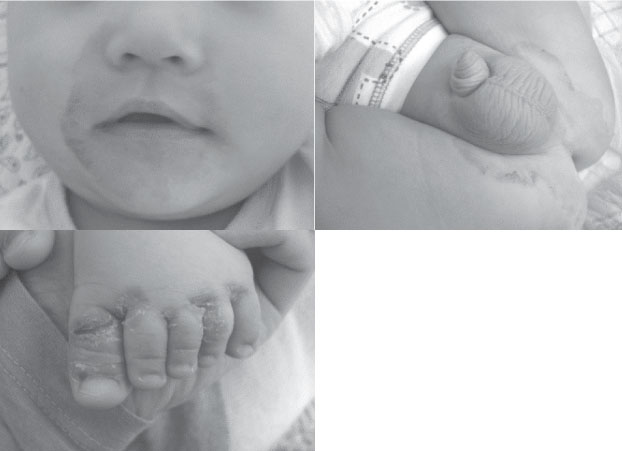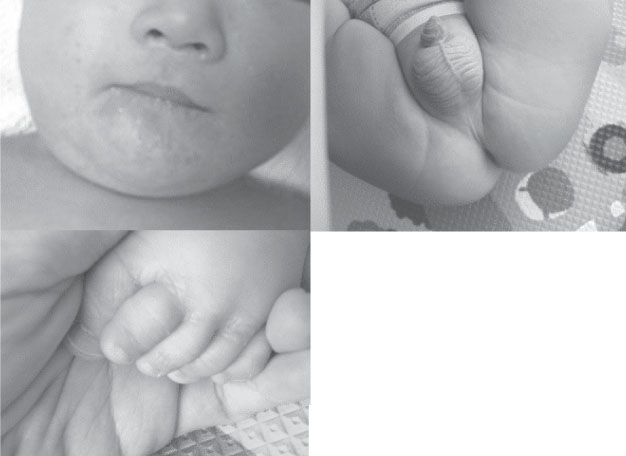Pediatr Allergy Respir Dis.
2012 Jun;22(2):204-208.
A Case of Zinc Deficiency Dermatitis in Breast Milk Fed Infant Mimicking Atopic Dermatitis
- Affiliations
-
- 1Department of Pediatrics, Eulji General Hostpital, Eulji University School of Medicine, Seoul, Korea. aym3216@eulji.ac.kr
Abstract
- Zinc deficiency can result from acrodermatitis enteropathica, an inadequate dietary intake, malabsorption, increased body loss, or intravenous feeding. Unlike acrodermatitis enteropathica, breast feeding-induced acrodermatitis is transient and improves when nursing ends. Breast feeding-induced acrodermatitis is caused by a ZnT-2 transporter dysfunction in the mother's mammary glands. We report a case of a 6-month-old male infant who presented with erythematous patches and plaques involving the perioral, perineal, and acral areas and loose stools since 2 weeks after birth. Atopic dermatitis was considered initially, but the lesions did not respond to topical antibiotics, corticosteroids, or maternal dietary restriction from allergenic food. The patient's serum zinc concentration was low, and the mother's serum and milk had low zinc levels. The differential diagnosis for atopic dermatitis is extensive. Physicians should be alert for the possibility of zinc deficiency dermatitis in breast milk fed infants that mimics atopic dermatitis.
Keyword
MeSH Terms
Figure
Reference
-
1. Leonard D, Koca R, Acun C, Cinar S, Estürk E, Ustündag G, et al. Visual diagnosis: three infants who have perioral and acral skin lesions. Pediatr Rev. 2007. 28:312–318.
Article2. Barceloux DG. Zinc. J Toxicol Clin Toxicol. 1999. 37:279–292.
Article3. Mocchegiani E, Muzzioli M, Giacconi R. Zinc and immunoresistance to infection in aging: new biological tools. Trends Pharmacol Sci. 2000. 21:205–208.
Article4. Prasad AS. Zinc: role in immunity, oxidative stress and chronic inflammation. Curr Opin Clin Nutr Metab Care. 2009. 12:646–652.
Article5. Krebs NF, Reidinger CJ, Hartley S, Robertson AD, Hambidge KM. Zinc supplementation during lactation: effects on maternal status and milk zinc concentrations. Am J Clin Nutr. 1995. 61:1030–1036.
Article6. Vasák M, Hasler DW. Metallothioneins: new functional and structural insights. Curr Opin Chem Biol. 2000. 4:177–183.
Article7. Calesnick B, Dinan AM. Zinc deficiency and zinc toxicity. Am Fam Physician. 1988. 37:267–270.8. Vallee BL, Falchuk KH. The biochemical basis of zinc physiology. Physiol Rev. 1993. 73:79–118.
Article9. Kiechl-Kohlendorfer U, Fink FM, Steichen-Gersdorf E. Transient symptomatic zinc deficiency in a breast-fed preterm infant. Pediatr Dermatol. 2007. 24:536–540.
Article10. Liuzzi JP, Cousins RJ. Mammalian zinc transporters. Annu Rev Nutr. 2004. 24:151–172.
Article11. Maverakis E, Fung MA, Lynch PJ, Draznin M, Michael DJ, Ruben B, et al. Acrodermatitis enteropathica and an overview of zinc metabolism. J Am Acad Dermatol. 2007. 56:116–124.
Article12. Sandyk R. Zinc deficiency and cerebellar disease. Int J Neurosci. 1991. 60:21–26.
Article13. Huang L, Gitschier J. A novel gene involved in zinc transport is deficient in the lethal milk mouse. Nat Genet. 1997. 17:292–297.
Article14. Chowanadisai W, Lönnerdal B, Kelleher SL. Identification of a mutation in SLC30A2 (ZnT-2) in women with low milk zinc concentration that results in transient neonatal zinc deficiency. J Biol Chem. 2006. 281:39699–39707.
Article15. Domellöf M, Lönnerdal B, Dewey KG, Cohen RJ, Hernell O. Iron, zinc, and copper concentrations in breast milk are independent of maternal mineral status. Am J Clin Nutr. 2004. 79:111–115.
Article16. Sampson B, Kovar IZ, Rauscher A, Fairweather-Tait S, Beattie J, McArdle HJ, et al. A case of hyperzincemia with functional zinc depletion: a new disorder? Pediatr Res. 1997. 42:219–225.
Article17. Smith JC, Zeller JA, Brown ED, Ong SC. Elevated plasmz zinc: a heritable anomaly. Science. 1976. 193:496–498.18. Takahashi H, Nakazawa M, Takahashi K, Aihara M, Minami M, Hirasawa T, et al. Effects of zinc deficient diet on development of atopic dermatitis-like eruptions in DS-Nh mice. J Dermatol Sci. 2008. 50:31–39.
Article19. Aggett PJ, Harries JT. Current status of zinc in health and disease states. Arch Dis Child. 1979. 54:909–917.
Article20. Krol A, Krafchik B. The differential diagnosis of atopic dermatitis in childhood. Dermatol Ther. 2006. 19:73–82.
Article
- Full Text Links
- Actions
-
Cited
- CITED
-
- Close
- Share
- Similar articles
-
- A Case of Transient Acrodermatitis Enteropathica in A Breast-fed Full-term Infant
- A Case of Transient Acrodermatitis Enteropathica in a Full-Term Breast-Fed Infant
- A Case of Cow's Milk Allergy with Atopic Dermatitis
- Occurrence of Transient Acrodermatitis Enteropathica in 3 full-term Breast-fed Siblings
- Two Cases of Rickets that Developed as a Result of by Diet Restriction due to Atopic Dermatitis



